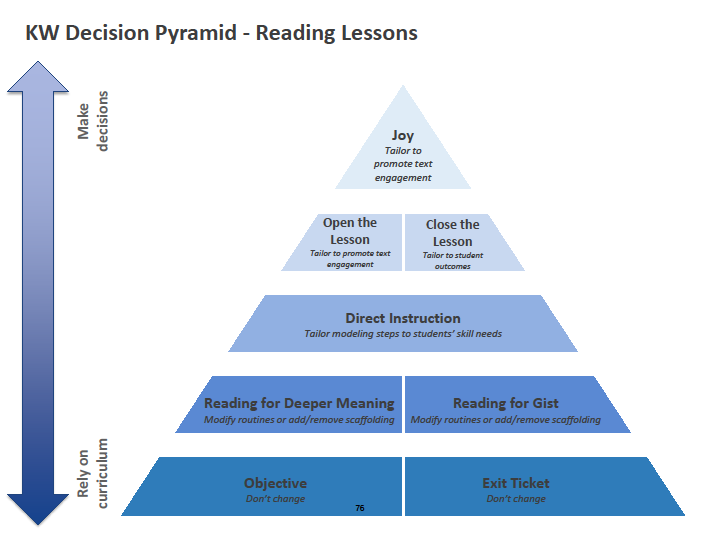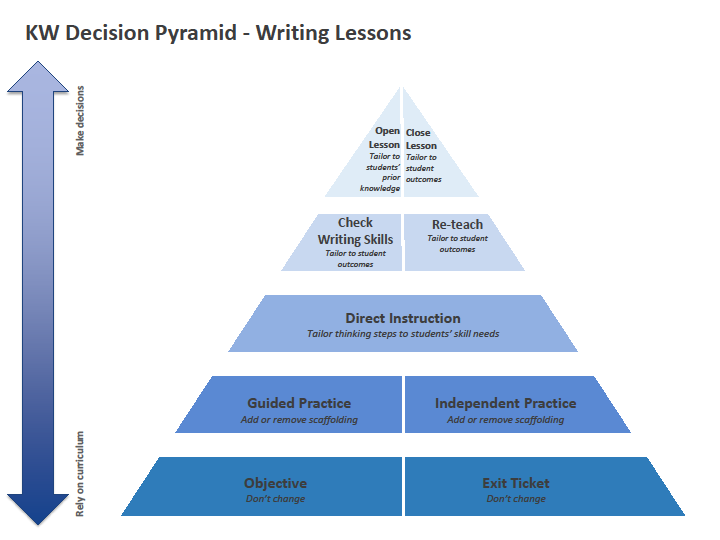Contents
DIFFERENTIATION OPTIONS CHART
Differentiation Strategies for Writing and Close Reading
Use this resource to explore and select options for differentiation and scaffolding in writing and close reading. It is important to remember that differentiating instruction is not “one size fits all.” Rather, it’s a dynamic process, based on the needs of students and demands of the content and curriculum. It is critical that teachers have an intimate understanding of each student’s needs in order to select appropriate differentiation strategies. This resource is part of the KIPP Wheatley Toolkit.
An important note for planning differentiation
Students who are multiple grade levels below in reading are often struggling in many areas of literacy. In order to close reading gaps, teachers need intimate knowledge of a student’s particular struggles and should consider:
- What are all the areas in which this student is struggling?
- What can I do to differentiate or scaffold for each area of need?
- How will I know that my approach is working?
| CURRICULUM ASPECT | STRATEGY TO CONSIDER | FUNCTION OF THE STRATEGY |
|---|---|---|
| Independent Reading of Complex Text | Pre-read text, or read an additional text on same topic or theme |
|
| Pre-teach critical vocabulary |
|
|
| Chunk text (identify shorter excerpts but keep objective constant) |
|
|
| Buddy reading |
|
|
| Reformat texts to include embedded definitions or picture cues |
|
|
| Provide structured overviews for some sections of text |
|
|
| Teacher reads aloud to a small group (read aloud could also be provided via technology – purchased, teacher recorded, student recorded, etc.) |
|
|
| Answering Questions | Add literal level text-dependent questions before moving to higher levels of critical thinking |
|
| Tackle small sections at a time to provide small wins |
|
|
Provide additional modeling once students have tried the task Heterogeneous pairing (strategic partnerships) of students |
|
|
| Provide sentence stems or frames |
|
|
| Highlight key ideas or details in the text |
|
|
| Modify graphic organizers to include picture cues or additional step-by-step directions |
|
|
| Post directions & anchor charts |
|
|
| Provide “hint cards” that give students more support with text-dependent questions |
|
|
| Indicate where students may find key information |
|
|
| Writing | Modify graphic organizers to include picture cues or additional step-by-step directions |
|
| Provide sentence starters & sentence frames |
|
|
| Provide word banks Provide models of similar writing products but with different topics |
|
|
| Collaborative Work | Monitor specific students more strategically (e.g. seating them closer to teacher) |
|
| Provide & model structured roles for group members during discussion or inquiry based work |
|
DIFFERENTIATION OPTIONS FOR ENGLISH LANGUAGE LEARNERS
Choose from the options below during Module Internalization and Planning to adjust module and lesson plans for English Language Learners. Emphasize the key principles of infusing lessons with oral language; limiting and simplifying language inputs; and supporting language with visual and/or kinesthetic symbols or markers.
A number of instructional routines can be particularly useful for English Language Learners. A few examples include TALK FIRST, SENTENCE FRAMES, and WORD BANK.
| Text Options | Reduce amount students read by one or more of the following methods:
|
| Standards Options |
|
|---|---|
| Focus Writing Tasks | Choose from these options to reduce the amount of writing students do:
|
| Pacing Options | Create time for lessons focused on background knowledge and language support by choosing one or more of these options:
|
| Reading Lesson Options | THROUGHOUT:
BEFORE THE LESSON:
ENGAGE:
READ FOR GIST:
PROVIDE DIRECT INSTRUCTION
READ FOR DEEPER MEANING
EXIT TICKETS
|
| Writing Lesson Options | ENGAGE:
DIRECT INSTRUCTION
GUIDE PRACTICE:
INDEPENDENT PRACTICE
CLOSE THE LESSON
|
LESSON PACING AND ENGAGEMENT
Sometimes time is tighter than you expected: a task took longer or students needed unanticipated support or review. Other times you need to increase student engagement in order to maintain interest and keep the lesson moving. During Writing instruction, you may need to slow down or add lessons to give students sufficient time to draft and to practice skills and strategies for effective writing.
Likewise, since active readers are usually the strongest comprehenders, it is important to support engagement and personal connections with texts. Sometimes a text is dense, difficult, in an unfamiliar format, or targeting a distant-seeming topic. In those situations, it’s important to augment student engagement, especially in the first lessons for the text.
Below and on the next page are some pyramids to help you understand what can or should not change in a Wheatley lesson. After the pyramids are suggestions for ways to adjust a Wheatley lesson when you need to move a little more quickly or need to increase student engagement.


This Decision Pyramid provides guidance for adjusting writing lessons to accommodate pacing or differentiation needs. The lighter sections at the top of the pyramid represent those sections that are most open to adjustment. When adjusting, keep the goal of the section constant, i.e., feel free to change the opening in a way that is more aligned to your students’ prior knowledge and interests, but keep the goal of creating readiness for the day’s skill. Within Direct Instruction, keep the skill and the process constant, but vary the modeling as needed for your students with more or less scaffolding as warranted. Another recommended adjustment is to model within the same writing task students are working on, but changing the examples or specifics so that students learn from what you show but cannot directly copy it.
Other Pacing Suggestions
The table below shows some other ways to adjust pacing for engagement or other purposes.
| LESSON SECTION | TEACHER OPTIONS |
|---|---|
| Reading | |
| Open the Lesson |
|
| Skill Instruction |
|
| Read for Gist |
|
| Read for Deeper Meaning |
|
| Close the Lesson |
|
| Writing | |
| Open the Lesson |
|
| Skill Instruction |
|
| Writing | |
| Guided Practice |
|
| Independent Writing |
|
| Independent Writing |
|
